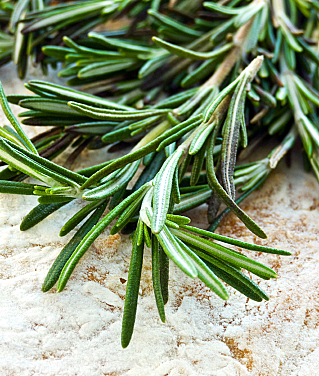
Rosemary is a charming shrub. Its Latin name Rosmarinus means dew-of-the-sea, probably because rosemary generally grows well by the seashore. It can reach about 1.5-3 meters in height. Its bushy stems and downy young shoots are covered with about 2 cm of long, narrow, needle-like aromatic leaves; dark green on top and grayish underneath with a piney scent. The plant bears pale blue, orchid-like flowers in early summer.
One of the loveliest of all herbal legends is the story of why rosemary has blue flowers. When the holy family fled into Egypt, an exhausted Mary spread her blue cloak on a white flowered rosemary. The flowers miraculously changed to the blue of Mary’s cloak. It has always been believed that wearing a sprig of rosemary brings good luck.

After years of extensive research, we now know that:
- The herb parts, especially flower tops, contain phenolic anti-oxidant rosmarinic acid as well as numerous health benefiting volatile essential oils such as cineol, camphene, borneol, bornyl acetate, α-pinene, etc.which are known to have anti-inflammatory, anti-allergic, anti-fungal and anti-septic properties.
- Rosemary leaves provide just 131 calories per 100 g and contain no cholesterol. Apart from nutrients, this humble herb contains many noteworthy non-nutrient components such as dietary fiber (37% of RDA).
- The herb is exceptionally rich in many B-complex groups of vitamin, such as folic acid, pantothenic acid, pyridoxine, riboflavin. It is one of the herbs containing high levels of folates, providing about 109 grams per 100 grams. It is also an excellent source of vitamin A and vitamin C.
- Rosemary herb parts, whether fresh or dried, are a rich source of minerals like potassium, calcium, iron, manganese, copper, and magnesium that also have health promoting properties.
- Rosemary oil which is distilled from the flowering tops contains volatile essential oil such as camphene, cineol, borneol, bornyl acetate and other esters. These compounds are known to have tonic, astringent, diaphoretic, and stimulant properties.
Native to the Mediterranean, rosemary has been used in many varied ways since ancient times. Apart from culinary and medicinal purpose rosemary shoots, flowers and leaves have household, decorative and practical usage.
Medicinal Uses of Rosemary
Rosemary has a number of important health benefits, among which are some of those that directly affect a child’s well-being:
- Rosemary leaves boost digestive functions and help to treat problems like constipation or diarrhea.
- If your little ones, or yourself for that matter, need an immune system or energy boost, indulge in some rosemary tea. It doesn’t need to be rosemary alone – you can marry it with thyme or peppermint, for instance.
- Rosemary tea is also a natural remedy for headaches, colds, fever, coughs and bronchitis.
- Asthma is becoming more wide-spread among children. Before you reach to the medicine cabinet remember a nature’s helper, like rosemary. Its leaves are very efficient in providing relief form this condition. Just make it a part of your kid’s diet and gradually you will see the benefits.
Culinary uses
Try to include this wonderful herb in your everyday cooking. It can be used in a variety of recipes to flavor poultry, pork, lamb, rice, tomato and egg dishes. In order to keep the fragrance and flavor intact, the herb is generally added to cooking recipes at the last moments, since prolonged cooking would result in the evaporation of its essential oils.
Fresh leaves can be sprinkled over salads, added to butters, sugars and oils, cool summer drinks, marinades and sauces for different meats and vegetables.
Here is an original recipe for healthy and somewhat unusual-to-some muffins, which can be consumed as substitute for bread or as a snack. Your kids will probably just love them.
Savory Muffins
Ingredients:
1 cup crumbled goat or feta cheese, your choice
1 tablespoon minced fresh (or 2 tablespoons dried) rosemary
1/2 cup chopped black olives
1/2 cup chopped sun-dried tomatoes
3 cups all-purpose flour
1 tablespoon baking powder
1/2 teaspoon baking soda
1 teaspoon salt
1 teaspoon sugar
10 tablespoons butter, softened
1 tablespoon Dijon mustard
2 large eggs
1 1/2 cups plain yogurt
Preparation:
Preheat oven to 375 degrees and adjust oven rack to lower-middle position.
Prepare the first three ingredients and set aside.
Mix flour, baking powder, baking soda and salt in a medium bowl and set aside.
In a separate large bowl, beat sugar and butter with an electric mixer til fluffy. Gradually add mustard and eggs. Beat for a few minutes. Stir the olives and the dried tomatoes into the wet ingredients. Stir the cheese and the rosemary into the dry ingredients.
Alternating by thirds, stir the dry ingredients and the yogurt into the wet ingredients until a very thick batter forms.
Lightly oil 12 large muffin tins of 1/2 cup capacity or four mini-muffin tins with vegetable oil or spray.
Divide batter evenly among the cups (a spring-action regular or mini ice cream scoop works). Muffin cups will be full. You can also bake in a cake pan, if you wish.
Bake until golden brown. Cool slightly in the pan, then remove and serve!
Like what you read? Sign up for our free newsletter so you can be informed of the latest FREE webinars & teleclasses, parenting articles, & weekly raffles.
Renata Shishkova is a mother and a grandmother, a writer and an artist from Toronto, Canada. She holds a Master’s degree and has a strong interest and background in nature, healthy living and wellness, and the challenges of parenting. You can read her insights at http://blog.kytephone.com
* Healthy Living is section of our website co-hosted by Lemi Shine. Lemi Shine has compensated Mommybites to be a partner in this awesome Healthy Living section on our website. This partnership does not influence the content, topics or posts made on this blog. We always give our honest opinions, findings, beliefs, or experiences on all topics, products, and services.
The views and opinions expressed on this blog are purely the blog contributor’s. Any product claim, statistic, quote or other representation about a product or service should be verified with the manufacturer or provider. Writers may have conflicts of interest, and their opinions are their own.




Comments are closed.